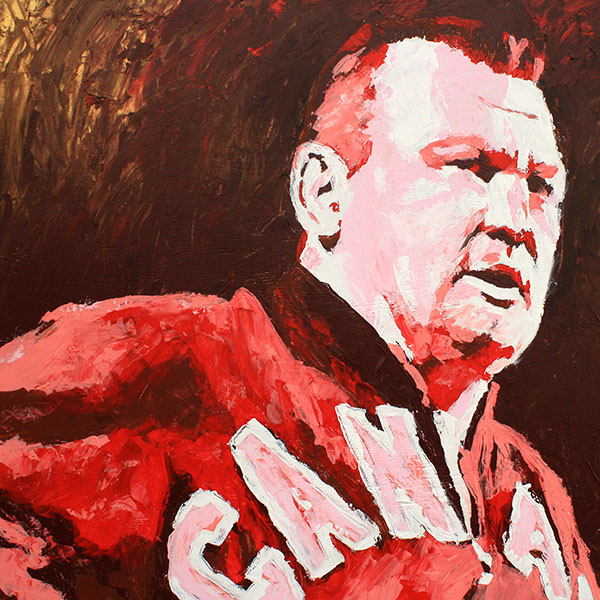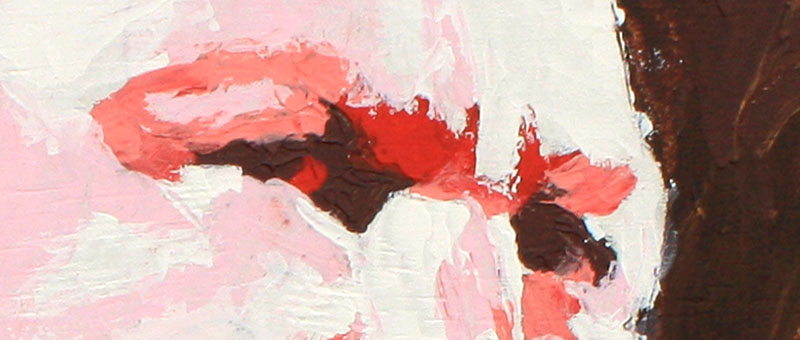
Acrylic on 24″ x 24″ wood
While Gene Kiniski declared himself to be Canada’s Greatest Athlete, few can dispute the highly-decorated and respected big man’s claim. Eugene Nicholas Kiniski was born on November 23, 1928 in Edmonton, Alberta, Canada, the young man was a natural pick for football due to being over six feet tall at only 17 years of age. While he also competed in amateur wrestling, he was normally the lone heavyweight competing. In 1949 attended the training camp for the Edmonton Eskimos, along with fellow future wrestling star Stu Hart, and one of his teammates was Wilbur Snyder. He played with the team until 1953, when he suffered a torn kneecap. Near the end of his football career, he began training with Dory Funk, Sr, and debuted on February 13, 1952, following in the footsteps of another football-to-wrestling star in Bronko Nagurski.
First working in California, he quickly became a star working against Wilbur Snyder, Bobo Brazil, John Tolos and within a year challenging Lou Thesz for the National Wrestling Alliance World Championship in a losing bid. After a brief yet successful time in Texas, he began working in Toronto in 1956, and the next year teaming with Buddy Rogers to battle Whipper Billy Watson and Pat O’Connor, seeding a long feud with Watson. He also unsuccessfully challenged Dick Hutton for the NWA Title during this time. He also had a notable rivalry with Edouard Carpentier and became a tag team champion with Don Leo Jonathan.
In 1960 he joined the American Wrestling Association and soon defeated Verne Gagne for the AWA World Championship on July 11, 1961, although he lost it back within a month. In 1962 he went to Vancouver for the peak run of his career, winning numerous titles and multiple world title challenges. With Vancouver as his home base, he also ventured to the World Wide Wrestling Federation and had a bitter rivalry with WWWF’s Champion Bruno Sammartino. On August 21, 1965 he defeated Dick the Bruiser for the Indianapolis version of the World Wrestling Association World Heavyweight Championship, holding it until Christmas of that year.
On January 7, 1966 he finally defeated Lou Thesz for the NWA World Championship in St. Louis, MO and went on to hold it for three years. As a fighting heel champion, he defended it against a who’s who of legends including Bobo Brazil, Dick the Bruiser, Johnny Valentine, Bill Watts, Carpentier, O’Connor, Thesz, Bearcat Wright and the sons of his trainer, Terry Funk and Dory Funk, Jr. On February 11, 1969 in Tampa, FL he was finally defeated by Dory Funk, Jr for the title.
He continued to win regional championships everywhere he competed, and later transitioned into promoting. As his in-ring career slowed down, he would still make appearances with his sons Kelly and Nick, refereed the main event of the first NWA Starrcade between Ric Flair and Harley Race, and even making his final in-ring appearance on February 25, 1992, nearly forty years to the day after his debut, defeating Bulldog Bob Brown in a singles match and later teaming with Chris Jericho and Lance Storm to tackle Brown, Gerry Morrow and The Natural. He was inducted into the National Wrestling Hall of Fame in 2004, the Professional Wrestling Hall of Fame in 2008 and the National Wrestling Alliance Hall of Fame in 2009. Gene Kiniski passed away in his home on April 14, 2010.
About the piece: I normally try to avoid doing anything ‘on the nose’, but with how much Kiniski symbolized Canada I thought it was fitting to limit the palette to shades of red and white, the colors of Canada’s flag. I also didn’t use any black on this, letting the burnt sienna be the darkest hue used.

